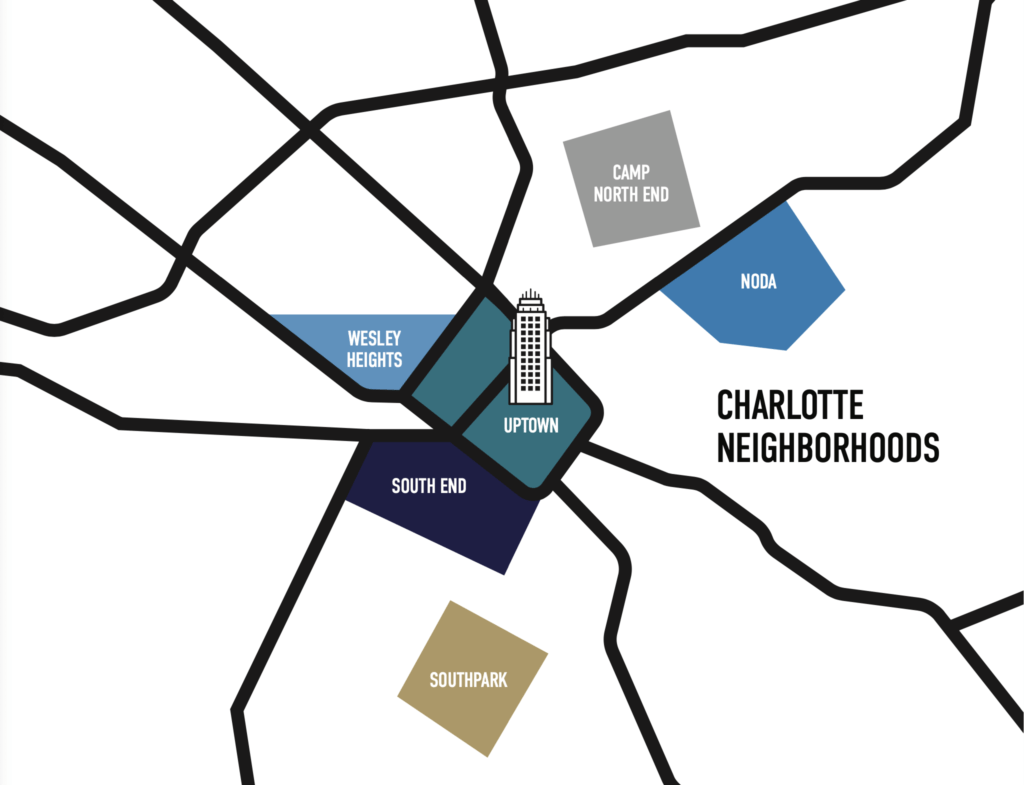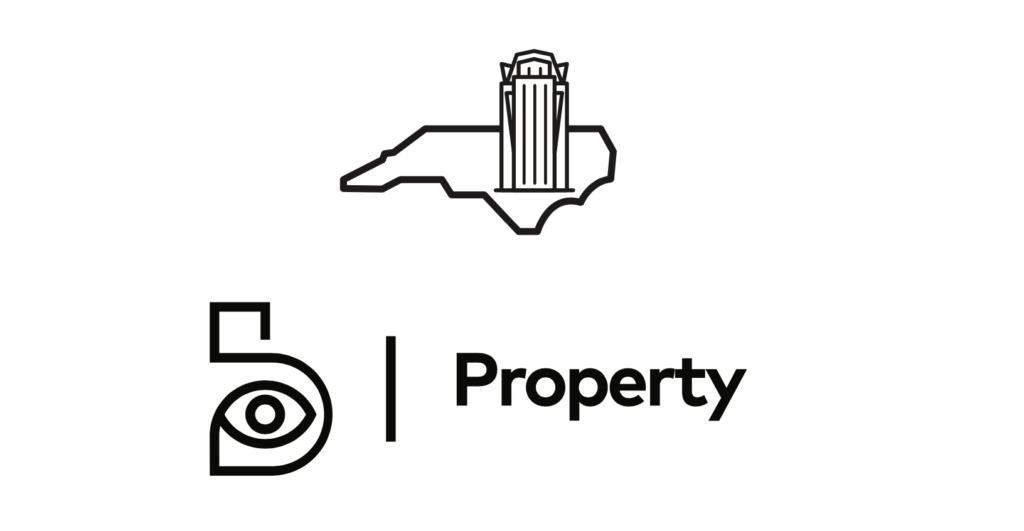
Living everything you wanted to know about the makes the Queen City so great to live in from the people that call it home. Download our Charlotte, North Carolina Report to review all of the details.
Charlotte, NC: Fast Facts
Charlotte is the 16th most populous city in the United States and the seat of Mecklenburg County. It sits atop a long rise between two creeks, Sugar Creek and Irwin Creek, and was built on the gunnies of the St. Catherine’s and Rudisill gold mines.
Between 2017 and 2018 the population of Charlotte, NC grew from 859,052 to 872,506, at 1.57%. That’s 60 new people added every day, on average and is home to more than 800,611 people. Based on U.S. Census data from 2005 to 2015, Charlotte tops the U.S. in millennial population growth.
Many corporate headquarters call Charlotte home, such as Bank of America, Truist Financial (previously SunTrust and BB&T), and Wells Fargo. Charlotte Douglas International Airport is the 7th busiest airport in the world.
People from Charlotte are referred to as “Charlotteans”.
I moved from Orlando to Charlotte. So I used to go to a lot of chains here and then moving to Charlotte. There’s a lot of mom and pop places and that was really fun just to be able to try all these new places that I would never try anywhere else besides Charlotte.
Kathie B.

Charlotte Neighborhoods
Uptown (downtown Charlotte area): A striking symbol of the New South where traditional industry blends with innovation and creativity. As you zoom in on the iconic Charlotte skyline to the city’s center at the intersection of Trade and Tryon streets, you’ll find a bustling metropolis divided into four wards. Upscale cocktail bars and rooftop patios fill up steadily with both locals and visitors, buzzing with an energy not unlike that of the city streets below.
South End: A short walk, bike or light rail ride down South Boulevard will bring you to Charlotte’s booming South End, home to some of the city’s best restaurants, boutiques and nightlife. Young professionals (and their dogs) spill out of luxury apartments toward the area’s craft breweries and coffee shops. Art lovers go gallery hopping and explore dozens of brightly colored murals painted throughout the neighborhood by local artists, while foodies fawn over mouthwatering menu items at newly-opened eateries.
NoDa: Just a few minutes north of the city center by car or LYNX light rail, you’ll find Charlotte’s arts and entertainment district, NoDa (so named for its main drag, North Davidson Street). Brightly colored murals, galleries filled with local artwork, live performance spaces and more await in this hipster haven, which was once home to turn-of-the-century textile mills — as do ample restaurants, coffee shops, bars and breweries.
SouthPark: Centered around a bustling retail district, SouthPark invites residents and visitors to revel in the finer things in life. This upscale Charlotte neighborhood plays host to high-end eateries and watering holes, ample boutiques boasting the latest trends, massive homes with perfectly manicured lawns and luxury apartments with amenities galore. Along the main thoroughfares of Sharon, Fairview and Colony roads, tree-flanked old
houses and schools make this an idyllic place for families and professionals to call home.
Wesley Heights: The west end of Charlotte – sometimes referred to as FreeMoreWest – is booming. New coffee shops, restaurants and breweries are popping up all over this area, just minutes from both Uptown and I-77. Residents here can skip the stress of street parking, instead opting to walk to Carolina Panthers games at Bank of America Stadium or Charlotte Knights games at BB&T Ballpark. Here, historic homes on tree-lined streets still offer skyline views of Center City — so it’s no wonder the neighborhood continues to see such massive growth.
Camp North End: Explore Charlotte’s largest adaptive reuse project, a space where entrepreneurs, artists, and community builders connect and create like never before. Camp North End’s oldest buildings date back to 1924, when Henry Ford assembled Model T and Model A cars. Today, inspiration is around every corner of this 76-acre urban playground. Home to coworking spaces, art galleries, and the design labs and production studios of a dozen leaders in their field, Camp North End has made a name for itself as the hub for Charlotte’s creative professionals.

Doing Business in Charlotte
As of 2019, Charlotte has seven Fortune 500 companies in its metropolitan area. Listed in order of their rank, they are: Bank of America, Honeywell, Nucor, Lowe’s, Duke Energy, Sonic Automotive, and Brighthouse Financial.
Key Industries: Finance & Insurance, Health Care & Social Assistance, Retail Trade, Accommodations & Food Services, and Professional, Scientific & Technical Services
Major Employers: Atrium, Wells Fargo Company, Charlotte-Mecklenburg Schools, Wal-Mart Stores, Bank of America Corporations, Novant Health
Compared to other places, Charlotte, NC has an unusually high number of Finance & Insurance (2.5 times higher than expected), Information (1.43 times), and Administrative & Support & Waste Management Services (1.4 times) industries.
“There’s always something going on and you can find just about any store or restaurant. Price is affordable and employment is everywhere.”
Janna K.
Cost of Living in Charlotte
Households in Charlotte, NC have a median annual income of $60,764, which is less than the median annual income of $61,937 across the entire United States. Per capita income in Charlotte is $36,426. The cost of living is 5% lower than the national average.
In Charlotte, the medium rent is $1,068 for a one-bedroom apartment and $1,193 for a two-bedroom. Rents have declined 0.2% over the past month, and are down significantly by 2.9% in comparison to the same time last year.
What Charlotte Renters Want
Climate Control: In a city that experiences both freezing winters and the heat of southern summers, utility costs can become a burden. You can either find an apartment that is all bills paid, or expect to spend more than $150 a month on utilities during summer and winter peaks.
Upscale Amenities: A spa for your dog. Golf and boxing simulators in the gym. Private bars with wine storage for residents. A 24-hour concierge. The list of amenities in some new Charlotte apartment buildings sounds more like what you’d expect in a high-end resort than a rental unit where you might live for a year or two. But with a record number of high-end apartments under construction, buildings are turning to their amenities to stand out and try to lure renters.
Pet-Friendly: Lots of people have pets, making a pet-friendly place desirable for many renters and a must-have feature for others. 65% of people own a pet, according to the National Pet Owners Survey. The most popular pets are overwhelmingly dogs and cats.
Key-Fob Entry and Interior Hallways: Three-story walkups with outside breezeways used to be the norm in Charlotte. Now, apartment developers I talked to said they can’t recall the last time they built a community that didn’t have rooms stemming from interior hallways and controlled-access doors.
Luxury Courtyards: Complete with loungers, couches, fire pits, TVs and outdoor games. Some first-floor units open directly out to the central courtyards.
One of my favorite things about living in Charlotte is that if you want to go to the mountains, that’s like a two hour drive North. Or if you want to go to the beach, it’s like a four hour drive South.
Brandie K.
Banking in Charlotte
Many corporate headquarters call Charlotte home such as Bank of America, Truist Financial, Wells Fargo along with other financial institutions has made it the second-largest banking center in the United States since 1995.
Wells Fargo has 24,000 regional employees. Bank of America has 15,000 regional employees.
Three major Finance and Insurance Industry Employers are Wells Fargo, Bank of America, and TIAA.
Read the full research report: Charlotte, NC Report. We interviewed Charlotteans to find out why they live there what makes their city special. Stay tuned for more city research.



